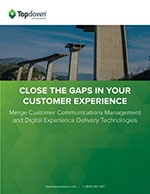Communications
Everything you need to know about customer communications and customer experience!

Customer Experience | Data | Digital Asset Management
By:
John Zimmerer
December 7th, 2015
We’ve been writing a lot about sharing content and integrating data lately. The reason we keep harping on those ideas is because they are what feeds brand consistency. And brand consistency is vital to building recognition, trust and value in the eyes of consumers. The consistency of your brand goes far beyond making sure the company’s logo and colors are right in marketing materials. It pertains to the entirety of how people perceive your company and its products and services. This consistency is built over time, a cumulative image made of all the impressions and interactions customers have with the company. In that sense, it’s a big part of the overall customer experience.

Customer Experience | Customer Communications
By:
John Zimmerer
November 21st, 2015
What Is ETL? ETL stands for Extract, Transform and Load. It refers to a database usage process that pulls data from one or more data sources; transforms the data, or changes it to a format or structure that is accessible for queries and suitable for analysis; and loads it into the final target database, data warehouse or application. Typically, since data extraction can take some time – particularly when it’s consolidating large amounts of information from different sources – the transformation and loading steps may begin before extraction is complete. This means that while data is being pulled, a transformation process can execute, preparing the data for loading; data loading may then begin without waiting for the completion of the other phases.


Customer Experience | Customer Communications | Digital Asset Management
By:
John Zimmerer
November 2nd, 2015
At Topdown, we don’t make a digital asset management (DAM) solution. But since we do make customer communications management (CCM) solutions, and CCM software needs access to digital assets to function, we spend a lot of time thinking about DAM-related issues. As we develop our next generation of CCM software, we see the need to address DAM in three categories: classic enterprise content management (ECM), traditional DAM, and parts of documents. This article looks at those three categories, and at how to get the most out of them today and in the future.

Customer Experience | Digital Asset Management
By:
John Zimmerer
October 28th, 2015
Writing for DAM News, Ralph Windsor covers “The Confused Picture of Enterprise Digital Asset Management Adoption.” The confusion the title refers to pertains to the outcomes of two seemingly contradictory studies. In the first study, conducted by Kable, analysts found that about 75% of larger businesses now have digital asset management (DAM) technologies. However, a report commissioned by the Chief Marketing Officer Council says that only 27% of large businesses have any ability to curate, organize and manage their assets across teams. We agree with most of Windsor's conclusions, but think he may have missed the larger point.

Customer Experience | Digital Asset Management
By:
John Zimmerer
October 26th, 2015
Role of Digital Assets in Customer Communications Management From the perspective of customer communications management (CCM), there are two – really two-and-a-half – kinds of digital assets. There are fully-formed assets, which are documents, forms, and other items we might use as attachments to communications. And there are traditional digital assets that are really components – like logos, photos, videos, copy, and so on – which we would use to build communications to be sent out to customers. The “half” refers to other kinds of components, like templates, layouts, styles, logic and reusable content objects. These are the “unsung heroes” of CCM. They’re what enable scalable personalization and automation in customer communications – communications that adhere to brand consistency, no matter how much correspondence you generate.

Customer Experience | Customer Communications | Digital Asset Management
By:
John Zimmerer
October 19th, 2015
Interoperability, or the ability to share and manage information between systems within and across an organization, is critically important to business success, but many existing digital asset management (DAM) solutions fail to adequately address the need. Moreover, most organizations have (often many) more than three asset management systems, making DAM interoperability a high priority. Ralph Windsor sums up the problem better than I ever could: “The DAM industry is guilty of self-obsessed and narcissistic behavior or (at best) an apathetic and fatalistic attitude that assumes interoperability is someone else's problem which might never get solved anyway….Meanwhile, the ongoing DAM interoperability crisis smolders away and users whose assets are sourced from another system (whether another DAM or a different class of enterprise application entirely) continue to grapple with complex and expensive custom integration projects that try to fill a void which should be occupied by a definitive industry-wide standard.” So what’s to be done? The Organization for the Advancement of Structured Information Standards (OASIS) is on it. They’ve established Technical Committees to assess the problem and offer solutions. Beginning with CMIS and proceeding to CMIS4DAM, the OASIS standards community has been working to define how enterprise content management (ECM) and DAM solutions should work together.